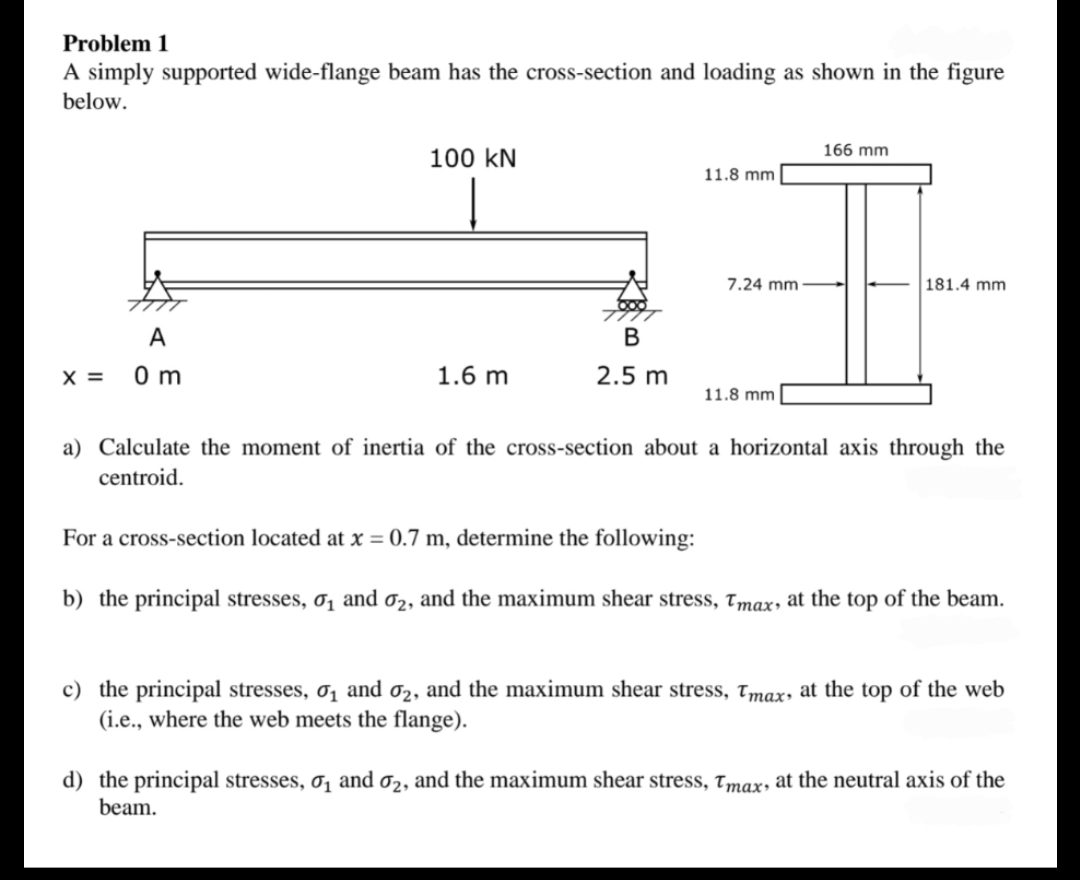A simply supported wide-flange beam has the cross-section and loading as shown in the figure below. X = A 0 m 100 KN 1.6 m B 2.5 m 11.8 mm. 7.24 mm 11.8 mm 166 mm 181.4 mm a) Calculate the moment of inertia of the cross-section about a horizontal axis through the centroid. For a cross-section located at x = 0.7 m, determine the following: b) the principal stresses, ₁ and 2, and the maximum shear stress, Tmax, at the top of the beam. c) the principal stresses, ₁ and 2, and the maximum shear stress, Tmax, at the top of the web (i.e., where the web meets the flange). d) the principal stresses, 1₁ and 2, and the maximum shear stress, Tmax, at the neutral axis of the beam.
A simply supported wide-flange beam has the cross-section and loading as shown in the figure below. X = A 0 m 100 KN 1.6 m B 2.5 m 11.8 mm. 7.24 mm 11.8 mm 166 mm 181.4 mm a) Calculate the moment of inertia of the cross-section about a horizontal axis through the centroid. For a cross-section located at x = 0.7 m, determine the following: b) the principal stresses, ₁ and 2, and the maximum shear stress, Tmax, at the top of the beam. c) the principal stresses, ₁ and 2, and the maximum shear stress, Tmax, at the top of the web (i.e., where the web meets the flange). d) the principal stresses, 1₁ and 2, and the maximum shear stress, Tmax, at the neutral axis of the beam.
Chapter2: Loads On Structures
Section: Chapter Questions
Problem 1P
Related questions
Question
Need help with b,c,d. Need further elaboration on solution provided before please

Transcribed Image Text:Problem 1
A simply supported wide-flange beam has the cross-section and loading as shown in the figure
below.
X =
A
0m
100 KN
1.6 m
B
2.5 m
11.8 mm
7.24 mm
11.8 mm
166 mm
181.4 mm
a) Calculate the moment of inertia of the cross-section about a horizontal axis through the
centroid.
For a cross-section located at x = 0.7 m, determine the following:
b) the principal stresses, 0₁ and ₂, and the maximum shear stress, Tmax, at the top of the beam.
c) the principal stresses, σ₁ and 2, and the maximum shear stress, Tmax, at the top of the web
(i.e., where the web meets the flange).
d) the principal stresses, 0₁ and 02, and the maximum shear stress, Tmax, at the neutral axis of the
beam.
Expert Solution
This question has been solved!
Explore an expertly crafted, step-by-step solution for a thorough understanding of key concepts.
This is a popular solution!
Trending now
This is a popular solution!
Step by step
Solved in 5 steps with 5 images

Follow-up Questions
Read through expert solutions to related follow-up questions below.
Follow-up Question
The Q used in calculating the shear stress in the web does not seem correct. Can you please elaborate?
Solution
Knowledge Booster
Learn more about
Need a deep-dive on the concept behind this application? Look no further. Learn more about this topic, civil-engineering and related others by exploring similar questions and additional content below.Recommended textbooks for you


Structural Analysis (10th Edition)
Civil Engineering
ISBN:
9780134610672
Author:
Russell C. Hibbeler
Publisher:
PEARSON

Principles of Foundation Engineering (MindTap Cou…
Civil Engineering
ISBN:
9781337705028
Author:
Braja M. Das, Nagaratnam Sivakugan
Publisher:
Cengage Learning


Structural Analysis (10th Edition)
Civil Engineering
ISBN:
9780134610672
Author:
Russell C. Hibbeler
Publisher:
PEARSON

Principles of Foundation Engineering (MindTap Cou…
Civil Engineering
ISBN:
9781337705028
Author:
Braja M. Das, Nagaratnam Sivakugan
Publisher:
Cengage Learning

Fundamentals of Structural Analysis
Civil Engineering
ISBN:
9780073398006
Author:
Kenneth M. Leet Emeritus, Chia-Ming Uang, Joel Lanning
Publisher:
McGraw-Hill Education


Traffic and Highway Engineering
Civil Engineering
ISBN:
9781305156241
Author:
Garber, Nicholas J.
Publisher:
Cengage Learning